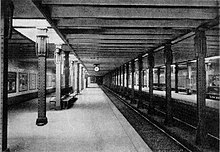Deutsche Oper (Berlin U-Bahn)
This article needs additional citations for verification. (December 2009) |
 Eastern entrance | |||||||||||
| Location | Bismarckstraße/Krumme Straße Charlottenburg, Berlin Germany | ||||||||||
| Coordinates | 52°30′43″N 13°18′38″E / 52.51194°N 13.31056°ECoordinates: 52°30′43″N 13°18′38″E / 52.51194°N 13.31056°E | ||||||||||
| Owned by | Berliner Verkehrsbetriebe | ||||||||||
| Operated by | Berliner Verkehrsbetriebe | ||||||||||
| Platforms | 2 island platforms | ||||||||||
| Tracks | 4 | ||||||||||
| Connections | |||||||||||
| Construction | |||||||||||
| Structure type | Underground | ||||||||||
| Bicycle facilities | Yes | ||||||||||
| Disabled access | No | ||||||||||
| Other information | |||||||||||
| Fare zone | |||||||||||
| History | |||||||||||
| Opened | 14 May 1906 | ||||||||||
| Services | |||||||||||
| |||||||||||
 | |||||||||||
| Location | |||||||||||
 Deutsche Oper Location within Berlin | |||||||||||
Deutsche Oper is a station of the Berlin U-Bahn on line U2, located in the Charlottenburg district. It is named after the Deutsche Oper Berlin.
Overview[]


The station opened on 14 May 1906 under the name Bismarckstraße in the course of the first western extension of the 1902 Stammstrecke route, which originally ran from Warschauer Brücke (now Warschauer Straße) to Knie (now Ernst-Reuter-Platz).
At the same time, the Wilhelmplatz (now Richard-Wagner-Platz) station was put in operation as the western terminus. The architect Alfred Grenander had designed Germany's first U-Bahn station with four tracks, in consideration of the future branch-off to Reichskanzlerplatz (now Theodor-Heuss-Platz) in Westend that went into service on 29 March 1908.
The station was renamed Städtische Oper on 1 August 1929, Deutsches Opernhaus on 16 August 1934, and received its current name on 22 September 1961.
Service between this station and Richard-Wagner-Platz (now on the U7) ceased on 1 May 1970, leaving the two central tracks unused, however the tunnel remains and is used for maintenance service between the U2 and U7 lines. U7 service to the new Bismarckstraße station began on 28 April 1978[2]
On 8 July 2000, during the Love Parade, a fire broke out at Deutsche Oper, injuring 21, destroying an U-Bahn train and severely damaging the station. As the only exits were at the western end of the platforms, passengers had to flee in the tunnel. As a result, the BVG decided to build a new eastern exit and reopened the station on 1 September 2000 in a renovated 1906 condition.
The walls are furnished with tiles designed by , a gift from the Portuguese ambassador in Berlin. The station is featured in Rammstein's 2004 music video for Mein Teil and also in the movie Run Lola Run by Tom Tykwer.
References[]
- ^ "Alle Zielorte". Verkehrsverbund Berlin-Brandenburg. 1 January 2021. p. 62. Retrieved 5 May 2021.
- ^ J. Meyer-Kronthaler: Berlins U-Bahnhöfe. be.bra Verlag (1996)
- Berlin U-Bahn stations
- Buildings and structures in Charlottenburg-Wilmersdorf
- Railway stations in Germany opened in 1906


